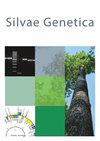黄松二代种子园球果生产的无性系育性、遗传力及种子作物的基因多样性
IF 1
4区 农林科学
Q3 FORESTRY
引用次数: 0
摘要
摘要通过对连续4年无性系间雌、雄球果产量的变化进行分析,并对黄松二代种子园球果产量的遗传变异、遗传力和遗传相关性进行研究。这个种子园是根据它们后代的体积生长来选择嫁接的。在整个调查期内,雌花的产量持续增加,而雄花的产量则有所波动。丰果年雌花的数量最多,丰果年和丰果年雄花的产量不一样。雄性指数表明,雄球茎在丰年和低年均出现雌雄亲本平衡。各年份雌球果产量的亲本平衡曲线比雄球果产量的亲本平衡曲线更接近于期望(即贡献更均等)。方差分析表明,4年期间雌、雄球果产量在无性系间存在显著差异。雄球茎的狭义遗传力高于雌球茎,说明雄球茎的生产受遗传控制。Pearson′s呈显著正相关,表明雌球茎的产量反映在雄球茎的产量上。有效亲本数在球果生产中、丰年最低。种子作物基因多样性的损失低于基于无性系育性变异的预期。本文章由计算机程序翻译,如有差异,请以英文原文为准。
Clonal fertility and heritability in strobilus production, and gene diversity of seed crops in a second-generation seed orchard of Pinus thunbergii
Abstract Variation of female and male strobilus production among clones over 4 consecutive years was estimated, and genetic variance, heritability, and genetic correlation in strobilus production were investigated in the second-generation seed orchard of Pinus thunbergii. This seed orchard was created with grafts selected according to the volume growth of their offspring. The production of female strobili continued to increase, whereas the production of male strobili fluctuated throughout the investigated period. The number of female strobili was highest in rich cone years, but the production of male strobili was not the same in rich or poor years. The maleness index showed a balance between female and male parents that occurred when male strobilus production was in rich or poor years. The parental balance curve for female strobilus production was closer to the expectation (i.e., more equal contribution) than that for male strobilus production in all years. The analysis of variance revealed significant differences among clones in female and male strobilus production over the four-year period. The narrow-sense heritability was higher in male strobilus production than female strobilus, implying that male strobilus production was under genetic control. The Pearson’s correlation was positive and mostly significant, indicating that female strobilus production was reflected in male strobilus production. The effective parent number was lowest in moderate and good years for cone production. The loss of gene diversity in seed crops was lower than expected based on clonal fertility variation.
求助全文
通过发布文献求助,成功后即可免费获取论文全文。
去求助
来源期刊

Silvae Genetica
农林科学-林学
CiteScore
2.20
自引率
10.00%
发文量
10
审稿时长
3 months
期刊介绍:
Silvae Genetica is an international peer reviewed journal with more than 65 year tradition and experience in all fields of theoretical and applied Forest Genetics and Tree breeding. It continues "Zeitschrift für Forstgenetik und Forstpflanzenzüchtung" (Journal of Forest Genetics and Forest Tree Breeding) founded by W. LANGNER in 1951.
 求助内容:
求助内容: 应助结果提醒方式:
应助结果提醒方式:


